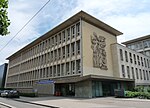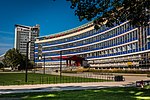Ecole et Observatoire des Sciences de la Terre
Buildings and structures in StrasbourgPublic universities in FranceUniversity of StrasbourgUse British English from August 2011
The École et Observatoire des Sciences de la Terre (English: School and Observatory for Earth Sciences) is an institution under the supervisory authority of the University of Strasbourg and the CNRS (French National Center for Scientific Research) in charge of education, research, observation in Earth Science and its diffusion. Situated in two buildings located on the central campus of the University of Strasbourg, EOST consist of more than 150 permanent employees among its staff.
Excerpt from the Wikipedia article Ecole et Observatoire des Sciences de la Terre (License: CC BY-SA 3.0, Authors).Ecole et Observatoire des Sciences de la Terre
Rue du Général Zimmer, Strasbourg Krutenau
Geographical coordinates (GPS) Address Nearby Places Show on map
Geographical coordinates (GPS)
| Latitude | Longitude |
|---|---|
| N 48.579722222222 ° | E 7.7619444444444 ° |
Address
Rue du Général Zimmer 1
67000 Strasbourg, Krutenau
Grand Est, France
Open on Google Maps










